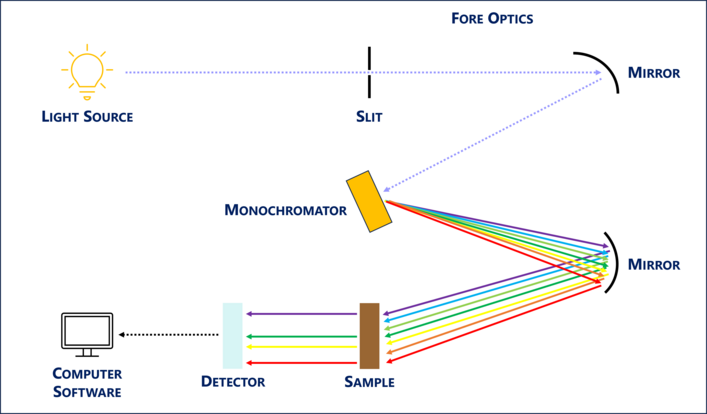Spectroradiometry for Earth and planetary remote sensing
[2] Combining the elements of spectroscopy and radiometry, spectroradiometry carries out precise measurements of electromagnetic radiation and associated parameters within different wavelength ranges.
[3] This technique forms the basis of multi- and hyperspectral imaging and reflectance spectroscopy, commonly applied across numerous geoscience disciplines, which evaluates the spectral properties exhibited by various materials found on Earth and planetary bodies.
[1] This variation is contributed by the presence of spectrally active components within the material, such as metallic oxides and clay minerals, which give rise to unique absorption features.
The specific shapes associated with the bands that occur at distinctive wavelength positions enable the identification of minerals and facilitate lithological interpretations.
[5] Spectroradiometry offers a simple, non-destructive, rapid, and efficient approach that complements traditional and heavy-duty geochemical methods, to characterize mineral assemblages and rock textures.
[6] Earth Sciences Portal Geology Remote Sensing In spectroradiometry, spectral features can be recognized and quantified by making use of the spectra containing different parameters measured by spectroradiometers.
Although some prominent patterns of absorption may be identified, they are prone to influence from the overall spectra trends, and features like amplitudes and magnitudes could mislead the interpretations under such circumstances.
[12] In order to facilitate data analysis, the raw reflectance spectra are commonly normalized to provide better visualization and quantification of trends and patterns of spectral parameters.
[8] These absorption features arise from the distinct electronic and vibrational processes associated with the energy, molecular components, and internal structures of minerals.
The drying process should be conducted at a temperature of 105 °C or below, which can ensure the removal of adsorbed water without causing any disruption to the internal structures of minerals.
[18][20] Considering the identification capabilities of spectroradiometry for different minerals and rocks, the comprehensive databases that encompass spectral signatures are crucial.
[16] These spectral libraries serve as essential references for ongoing research on spectroradiometry, providing a solid foundation for data analysis and interpretation.
[18][19] The third group of parameters concerns the effects of absorption contributed by Al-OH bonds in clay minerals including illite and kaolinite, which is situated near 2200 nm.
[16] These absorption bands become more asymmetric (AS2200 > 1, showing leftward asymmetry) with increasing kaolinite contents as a result of transformation from illite, implying greater extents of mineral alteration, degree of hydrolysis, and silicate decomposition, which serves as signals that indicate more advanced weathering stages.
[10] In contrast, mafic ashes, which have low silica content, exhibit lower reflectance due to their purity compared to the mixed compositions of the background sediments.
[24] Additionally, phyllosilicate minerals in volcanic ashes display strong absorption features near 2200 nm, attributed to the stretching of hydroxyl groups (-OH bonds) with aluminium.
[25][27] Meanwhile, non-imaging spectroradiometry, combined with field scanning and sampling, is suitable for localized applications, providing age implications and constraints for stratigraphic units.
[16][8] Using multi-, hyperspectral, and thermal imaging, the ages of surfaces of regional sediment deposits, such as alluvial fans, can be predicted and mapped.
Spectroradiometry, with its ability to identify Earth materials through capturing their distinctive spectral signals, holds significant potential in exploring and predicting the presence of ore deposits and hydrocarbon reservoirs.
[3] These alteration processes are often related to volcanic and geothermal activities, where hot hydrothermal fluids penetrate through fractures in pre-existing country rocks, resulting in the deposition of valuable metallic ores such as gold and copper.
[9][30] The intense weathering processes occurring in granitic rocks give rise to the denudation and leaching of major element oxides, leaving behind the highly decomposed regolith.
[9][30] Throughout the weathering process, clay minerals such as kaolinite and halloysite are generated as alteration products, which possess a strong affinity for adsorbing REEs, leading to their enrichment in the regolith.
[13][32] Making use of these spectral characteristics, combined with geochemical interpretations and machine learning, the identification and mapping of Nd-enriched regolith areas can be fostered, which may provide implications towards potential REE mineralization and respective ore bodies.
Similarly, the same approach can be used towards the identification of coal reservoirs through their associated coal-bearing rocks, based on the unique spectral imprints given by hydrocarbons, which spans the infrared wavelength regions.
[34] Spectroradiometry, with its ability to characterize surficial compositions and study the geology of these celestial bodies, is considered a key technique in planetary science.
Characterized by their paired absorption features near 2300 and 2500 nm, they are found along Nili Fossae, and Tyrrhena Terra located at the southern Martian highlands.
[34][35] This reflects the increasing of weathering intensity and the occurrence of aqueous processes on Martian crust, indicating that a wet and warm climate had once existed on the planet.
Sulphates commonly form as a result of the alteration of crustal materials by groundwater and rain, and the precipitation of evaporated water bodies.
[1][11] Spectral resolution concerns the capability of a sensor in a spectroradiometer to measure the light intensity according to specific wavelengths on the electromagnetic spectrum.
It describes the extent of spatial detail the sensors can record, i.e., the smallest feature detected, based on pixel and grid sizes of the captured digital imagery.



















